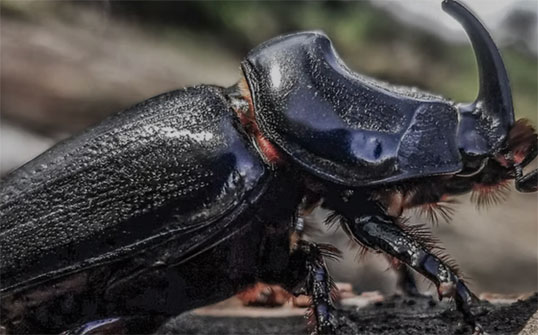
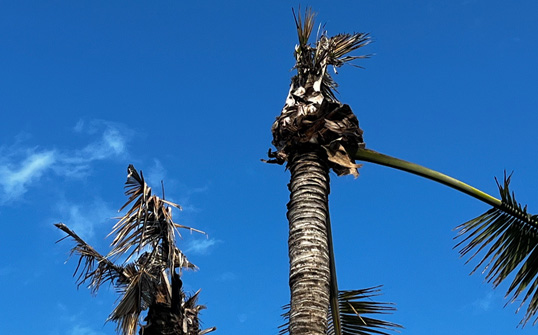
A Growing Threat to Our Trees and Our Community
The Coconut Rhinoceros Beetle (CRB) has entered Lanikai. If it fully takes hold, most of our coconut and other palm trees will die.
This invasive beetle bores into the crowns of palms—destroying new fronds, weakening the tree, and eventually killing it. Lanikai is home to MANY palms. Picture, if you will, a Lanikai WITHOUT coconut trees and other palms like royal palms, fan palms, and even areca palms. We’re at a critical moment to stop the infestation before it spreads out of control. Map of Known CRB Infestations in Lanikai
New Strategies Have Emerged
The way to beat CRB is two-fold: 1) natural biological controls; and 2) protecting individual trees.
- A Biological Insecticide that kills CRB. CRB is highly susceptible to a fungus that you can buy on Amazon and spray on your land and that has been used for decades by gardeners and nurseries. It works rapidly (3-10 days) and kills both adults and larvae. Here is a PDF on Biological Insecticides for CRB in Hawaii. This infects CRB where they live most of their lives: in soil and decaying vegetation.
- Protecting the Crown of Existing Trees. For this you need someone to climb your trees (e.g. a tree trimmer) and place substances or nets that discourage CRB from attacking that tree. See further below for the latest developments in this area.
Our Goal: Keep CRB at a Low Level in Lanikai
CRB is here in Lanikai. It's a fact. It's just starting and will get worse. Lanikai has some characteristics that may help our chances:
- Natural Isolation: Bounded by ocean and the Keolu Hills, Lanikai has fewer entry points for CRB to spread into the neighborhood.
- Community Resources: Lanikai is an upscale neighborhood where many residents can afford tree care, treatment, or removal as needed.
- Low Breeding Habitat: As a residential area, Lanikai has relatively little mulch, compost, or other green waste compared to other areas.
- Neighbors helping neighbors: Community association leadership on CRB is lacking. The State has shown that it's not up to the challenge. So it's up to individuals and neighbors helping neighbors to beat the beetle. Talk to your neighbors. Use this site as a guide to stop CRB in your part of Lanikai. In particular, utilize the long-term strategy of "biological insecticides" to put CRB in its place!
With these advantages and early, community-wide participation, Lanikai has a real chance to manage CRB and prevent the deaths of many many palm trees. Acting now could make Lanikai a model for CRB management across Hawaiʻi.
What You Can Do
- Educate yourself about CRB. See the Educational Resources section further below.
- Protect your coconut and palm trees with proactive measures (see immediately below)
- Spray the biological insecticide Metarhizium anisopliae on your land.
- Reduce or eliminate CRB breeding habitat on your property. Remove mulch piles, compost heaps, and accumulated organic debris like fallen fronds, dead branches, and dense vegetation under trees—any material where beetles might breed or hide.
- Immediately Remove CRB-infested trees plus any breeding habitat below them or in the vicinity. Stop the spread.
Protecting the Crown of Existing Trees
Front Inserts. Research in Hawaii has shown that certain essential oils repel and can kill CRB. When applied to the crowns of trees, these oils (as well as regular insecticides) repel CRB. The problem is that both oils and insecticides degrade and evaporate rapidly so they have to be re-applied every week or two to provide continuing protection. Thus the development of "frond inserts", which are materials that can hold essential oils (or insecticides) and emit them slowly over a period of months, and which are placed in the crevices between fronds and tree trunk where CRB normally enter the crown. Many materials have been tried (waxed rope segments, sponges, foam, wicks) with the latest innovation being beeswax "balls" impregnated with essential oils and "smushed" into the frond crevices.

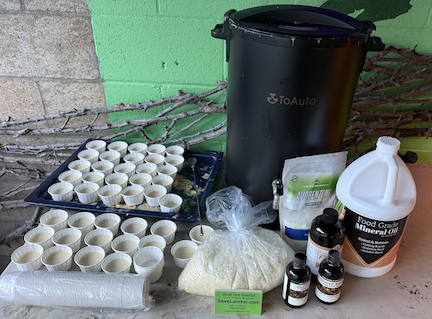
About 10-20 wax cups are needed per tree, depending on their type and "frondiness". The wax will not fall out of the tree, and will continue emitting essential oils for months, make those entry point unpalatable to CRB.
Once CRB infests a tree, there is litte recourse: the tree, unless only lightly damaged and the CRB (somehow) removed, must be cut down to prevent further spread of CRB. Thus, it is important to protect trees proactively. Following are some traditional and emerging methods.
- Netting trees. Research conducted in India, plus real-world experience in Hawaii, indicates the effectiveness of netting trees to keep CRB out of the crowns of trees. Netting must be regularly adjusted or renewed due to the growth of the trees. The type of netting and how it is deployed is extremely important. If wrapped too tight, the beetle can eat right through it. The best netting is 1" diagonal nylon fishing net, wrapped relatively loosely, that the beetles get stuck in trying to go through one of the holes in the netting, causing them to die. One source of netting is Memphis Net & Twine. Select netting with these specifications: 1/2" SQ., 1" STR., 110 MD which means each hole is 1/2" square but diagonally it's 1" when stretched. This is the perfect size as the beetles will try to squeeze through the holes and get stuck. Another approach is to wrap netting around small rocks (~2") and form "bow ties" of netting that are then put between the fronds where the CRB enters. This approach, from the University of Guam, is documented in this Youtube Video on the Bow Tie Trap.
- Frond inserts. This method utilizes an absorbent substance (tiki torch wicks, pieces of sponge) that are soaked in an essential oil mix (clove, cedarwood, basil) and then covered with wax to slow the emission of oils over a period of months. These inserts are then smushed into the crevices between coconut fronds and the tree body. A new method being developed is soft wax balls about 2" in diameter which have essential oils impregnated in them and which are likewise smushed into the crevices. After smushing, bow-tie nets can be applied to the crevices for additional protection.
- Ring Spray System. Recently developed by Oahu resident Brown Cannon Jr., this is a device mounted in the crown of each tree with a tube running down the trunk of the tree to the ground where it is hooked to a pump. Trees are periodically sprayed with a mixture containing basil oil, which UH has found is an excellent deterrent to CRB. Do-it-yourself instructions are included at the web site SaveHawaiianPalms.com. There's also great instructions on this website for building CRB traps.
- Regularly spraying the crown of the tree with insecticide. This is effective according to the Hawaii Invasive Species Council. Choice of insecticide is important, because some, like Permethrin, are UV sensitive and break down quickly. Others, like Lambda-cyhalothrin, are much less UV sensitive and can last for several months. Bees are very sensitive to these insecticides, so best practice is to trim the tree, apply insecticide, and then keep trimming and applying insecticide before coconut flowers emerge (every 1-2 months). Recommendation: Use other effective methods first to avoid the negative environmental impacts of these powerful insecticides.
- Injecting insecticide into the trunk of the tree. This is effective using chemicals such as Imidacloprid (Xytect) & Dinotefuran and must be repeated every 6-12 months or so. This is the method being used by the Honolulu Parks Department to save some of the coconut trees in urban Honolulu. It costs about $300/tree. Recommendation: Use other effective methods first to avoid the negative environmental impacts of these powerful insecticides. Coconuts eaten from trees poisoned in this manner have caused serious illness in humans.
- Spraying the crown of the tree with natural oils. Testing by Hawaii Invasive Species Council has shown that Neem oil is NOT very effective. However, Basil oil is effective as a repellant. In tests showing its effectiveness, Basil oil was applied every 3 weeks. Good info on Basil oil can be found at CRB Management Options for Landscape and Nurseries in Hawaii. Basil oil can also be incorporated into "frond inserts" as described immediately below.
- Moth balls. Research from India has shown the moth balls (Naphthalene) are effective at repelling CRB. The researchers worked with relatively young trees (3.5 years old) and simply put the mothballs between the fronds and renewed them every 45 days. They compared the moth balls with insecticide and found the moth balls worked better. In Hawaii, real world experience has shown that moth balls (about half inch in diameter) dissolve within a couple weeks, so are no longer recommended. [Maybe they have larger moth balls in India.] Frond inserts (described above) using essential oils are a better bet as they are designed to withstand the elements and continue to emit CRB-repulsive odors for months.
Ideal Protective Practice for Coconut Trees
- Avoid insecticides as they are toxic to honey bees and other pollinators, which we need
- Trim tree of all flowers and nuts.
- Apply one or more of:
- Frond inserts as described above
- "Bow Tie" nets as described above
- Spray the fungi Metarhizium anisopliae on all decaying vegetable matter every month
- Monitor, renew, and retrim every 1-3 months
- Remove mulch piles or spray month with Metarhizium anisopliae
Biocontrols, the final solution
- In other parts of the world, a virus, toxic to CRB, has been used to contain CRB.
- The strain of CRB in Hawaii, which came from Guam and is designated as CRB-G, developed resistance to the virus.
- UH is experimenting and running tests to see if a new virus can be developed and tested to make sure it does not harm any native beetle species here. This will take years, but will likely be successful.
- More promising still is a naturally occuring fungi called Metarhizium anisopliae which kills CRB in 3-10 days through infection and internal proliferation (not by "poisoning" per se). This fungi attacks both larval stages and adults and can be applied to mulch piles. It is already "in the wild" in Hawaii, and has been studied in Hawaii and proven effective. It is not widely used because it is not "registered" in the State of Hawaii. However, anyone can buy Metarhizium anisopliae online and apply it at will.
See this paper on Metarhizium anisopliae: Biological Insecticides for CRB in Hawaii
- Until biocontrol agents become widely dispersed in Hawaii's ecosystem, protecting individual trees, using the measures described above, AND managing CRB breeding areas like mulch piles, are the best short-term strategies.
How to Determine Where CRB Is
Once you see CRB damage in a tree it's likely already too late to save that tree. Thus we need earlier warning systems.
To determine if CRB are in an area requires deploying simple, cheap pheromone traps, of which there are many designs. These traps attract CRB by three different mechanisms: CRB pheromones; Light, including UV; Bait in the form of pieces of coconut tree and/or mulch
- Here are four short videos from the University of Guam that show how to make different types of pheromone traps:
- CRB DeFence Trap
- CRB Pile Trap
- CRB Barrel Trap
- CRB Bow Tie Trap
- Here are some additional links on building pheromone traps:
- SaveHawaiianPalms.com. has excellent info on building CRB traps.
- Pheromone trap made out of water bottles. from Grenada in the Caribbean.
- Here is a local source selling pre-made pheromone traps:
- ProAct Products. using pheromone plus a solar-powered UV light.
- Here is where you can buy CRB pheromone lure packets. The pheromone packets last about 30 days and then need to be renewed. The active chemical is Ethyl-4-methyloctanoate.
- CRB Lure from Evergreen Growers Supply
- HEDO Pheromone Lure on Amazon
- Contemporary Landscaping in Waimanalo sells the same pheromone lure packets as Evergreen.
See Where CRB Has Been Spotted in Lanikai
👉 Map of Lanikai Infestations
These are known infestations as of 13Oct25.
If you know of other infestations please contact me so we can update this map.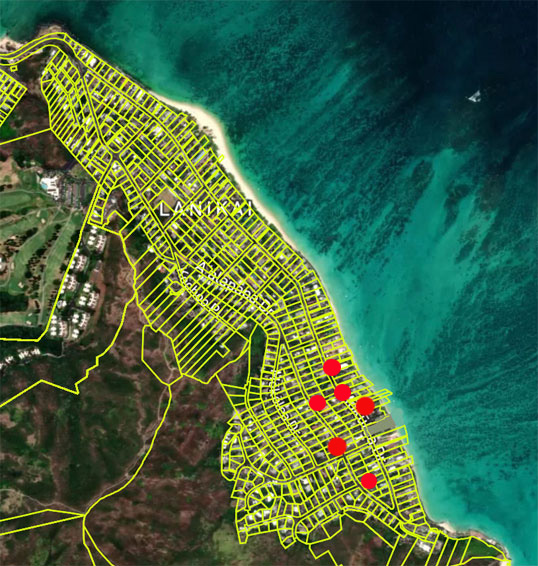
Aloha Organics on Oahu has developed a CRB Monitoring Map that allows anyone to report CRB from their phone or computer. Please also use this system if you detect CRB.
Educational Resources
- CRBHawaii.org is the first stop on your CRB educational journey. "CRB Response" provides information on CRB detection, prevention, treatment, and the latest research. It is funded through grants from UH, USDA, and DLNR. Follow them on Instagram here.
- Hawaii Invasive Species CRB 2025 Control Methods outlines the latest chemical and Biocontrol methods for containing CRB.
- 12 Years In: How Hawai‘i is Still Working to Curb the Coconut Rhinoceros Beetle 18Jun25
- CRB Management Options for Landscape and Nurseries in Hawaii From hawaiiscape.com 15Dec23
- Preliminary Trials on Use of Essential Oils for IPM of Coconut Rhinoceros Beetle UH Department of Tropical Plant and Soil Sciences, December 2023
- SaveHawaiianPalms.com. Excellent info on building your own ring spray systems and CRB traps. Also good discussions of netting and essential oils for repelling CRB.
- Dozens of CRB larvae discovered in garden soil sold at Oahu store August 2024 and it was Miracle Grow that he got at the Navy Exchange!
- Netting for Physical IPM of Coconut Rhinoceros Beetle. From UH Department of Tropical Plant and Soil Sciences. Good info and covers netting mulch piles as well.
Lanikai Strategic Action Plan
Lanikai has a chance to beat the beetle. Here is what needs to be done:
- Educate: Get residents and other stakeholders to realize the seriousness of this problem.
- Protect as many individual trees as possible using the means listed above.
- Deploy CRB pheromone traps around the community to assess CRB incidence, remembering that once you see evidence of CRB in a tree that tree is already infested.
- Remove infected trees ASAP to prevent further spread.
Tree Trimmers Who Can Help:
Here is contact information for tree trimmers who can help deploy protective measures for your trees. Tree trimmers, please contact us to get on this list.
- Miguel Miuralles and Eli Barros: 808-343-8063 and 808-497-0272
Photo & Video Gallery

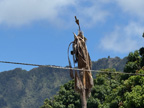
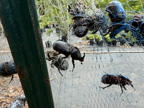
Click anywhere to close
Click anywhere to close
Help Save Lanikai's Palm Trees: Stay informed. And take action now—before it’s too late.
Join Our Mailing List
Stay informed about efforts to Save Lanikai
Brought to you by John Lindelow, Lanikai resident since 1999
Email: savelanikai@gmail.com or Text or Call